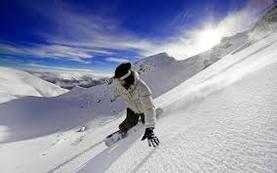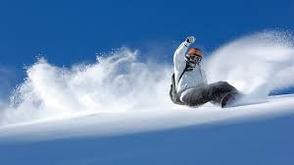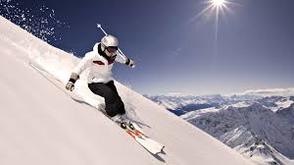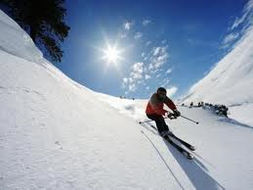 Snowboarding Injury Statistics Snowboarding Injury Statistics After recently returning from skiing in Perisher in NSW with the family I thought I would look at injury statistics and methods to prevent injury on the slopes. I have put together some basic information which will hopefully help those off snow skiing and snow boarding in Australia and overseas in the future. Snow Skiing and Snowboarding Injuries: statistics, risk factors, mechanisms of injury, and prevention.  Snowboarding Injury Types Snowboarding Injury Types Injury rates in Skiers / Snowboarders Whilst on the slopes there is about a 1% chance of injury on any given day. 40% of all injuries go unreported. Snowboarders are 2-5 times more likely to suffer an injury than skiers. In both skiing and snowboarding, beginners suffer almost three times more injuries than more experienced participants. One study documents 49% of injured snowboarders were beginners versus 18% of beginner skiers. In skiers the injury rate for anterior cruciate ligament (ACL) sprains has more than tripled since the late 1970s, while the incidence of every other injury has declined (modern ski boots transmit forces to the knee and contribute to making sprained knees the most common injury in alpine skiing). The incidence of ACL sprain represents 33% of all knee injuries. Teenagers suffer the highest overall rate of injury in any one age group. Women are more likely to sustain upper extremity injuries and are twice as likely to suffer an ACL sprain. Muscle strains and tendinitis are common overuse injuries seen in skiing and snowboarding. Factors affecting Injury Factors affecting injury include the grooming of slopes, ski instruction, safety innovations in ski areas, quality of ski equipment, snow conditions, visibility, number of skiers on the slopes, skier fatigue, and the use of alcohol and other drugs. Most injuries occur between 12 noon and 4 PM. The most critical determinants of injury, however, are skier ability, relation of speed to athletic proficiency, and improper adjustment or poor functioning equipment. It has been estimated that 44% of all downhill ski injuries are due to improper maintenance and adjustment of equipment. Failure of binding release occurs in 70% of lower leg fractures and serious knee injuries. Boots: Soft boots give the snowboarder twice the risk of ankle injury compared to hard boots. "Snowboarder’s ankle," a fracture of the lateral process of the talus, is caused by forced dorsiflexion and inversion at the ankle permitted by softer boots. Hard boots place the snowboarder at risk for "boot-top" fractures of the tibia and fibula as well as double the risk for knee injury. More commonly, snowboarders fall backward as they lose their heel-edge and suffer wrist impacts, buttock contusions, axial loading spinal compressions, and occipital head injuries. Poles: "Skier’s thumb," a sprain of the ulnar collateral ligament of the first metacarpophalangeal joint is the most common injury of the upper extremity affecting skiers. Ski poles are implicated in 24% of shoulder dislocations- causing the arm to be externally rotated and forcibly abducted in a fall. Wrist guards: for snowboarders, the wrist is the most common site of injury, accounting for ¼ of all injuries and ½ of all fractures. Wrist guards have been shown to be very effective in preventing wrist injuries. Falling backward is the mechanism of injury in about 75% of wrist injuries.  Snowskiing Injuries Snowskiing Injuries Mechanisms of Injury Falling: falling is the leading cause of skiing (87%) and snowboarding (75%) injuries. Skiers most commonly fall forward while snowboarders more often fall backwards. Jumping: Unsuccessfully landing jumps is the second most common cause of snowboarding injury. Snowboarders are injured three times more frequently jumping than are skiers. Collisions: collisions account for 10% of all injuries but 67% of hospital admissions. Most commonly collisions involve a stationary object, but often it is another person. Snowboarders have an increased rate of head injuries at 10% compared with skiers at 5%. Almost one quarter of snowboarding injuries occur during the person’s first experience. In one study wrist injuries predominated (41%) in the beginner group, shoulder injuries were most common (38%) in the intermediate group, and head injuries predominated (36%) in the expert group. Another study reported: beginning snowboarders were most likely to injure the wrists (30%); low intermediates, their knees (28%), intermediates, their ankles (17%), and advanced and experts, their shoulder or clavicle (14%).  Injury Prevention Injury Prevention Prevention Get in shape: regular general fitness and training will help reduce risk of injury. Avoid drugs and alcohol. Do not ski/snowboard if you are sick or fatigued. Equipment: be sure your equipment is properly maintained, repaired, or replaced. Wear protective eyewear, a helmet, and wrist guards if snowboarding. Dress properly in layers. Outer wear should be of a fabric to reduce sliding. Technique: snowboarders should fall with closed fists and try to roll into a fall, spreading the force of the fall out over the body instead of in one place. Those choosing to jump must know their landing site. Instruction: professional and certified instructors can significantly lessen injury rates and severity. Snow Conditions: avoid icy slopes. Do not ski alone in deep powder. Avoid crowded slopes, particularly at the end of the day. Responsibility: ski and ride within your ability. Watch for skiers downhill. Look uphill before entering a trail. Move to the side of the trail when stopping. Use devices to help prevent runaway equipment. Observe all posted signs and warnings. Have the ability to load and unload lifts. Practice courteous ski habits. "Look before you leap": use caution when jumping and leaping on the slopes, especially in snowboard and terrain parks. Keep safe on the slopes and have a great time in the snow. If you are unfortunate enough to suffer an injury whilst on the slopes call us at Dunsborough Physiotherapy Centre ph: 97553600 or visit our website for detailed information: http://www.dunsboroughphysio.com.au 29/10/2014 08:38:23 am
There a lot fun adventures in skiing. There are things to keep in mind to avoid accidents in vacation. Thanks for these! Comments are closed.
|
AuthorBen Liston of Dunsborough Physiotherapy Centre has over 25 years of physiotherapy experience. Archives
September 2016
CategoriesAll Hydrotherapy Massage Therapy Real Time Ultrasound RICER Injury Management Snow Skiing And Snowboarding Injury Prevention SPRIG Program (Injury Prevention Program For Children And Adolescents) Surfing Injury Info Winter Sports Injury Info |
Proudly powered by Weebly

 RSS Feed
RSS Feed